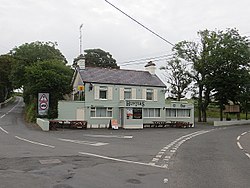Ballyvoy: Difference between revisions
No edit summary |
No edit summary |
||
| (One intermediate revision by one other user not shown) | |||
| Line 11: | Line 11: | ||
|population= | |population= | ||
|census year= | |census year= | ||
|townland=yes | |||
|LG district=Causeway Coast and Glens | |LG district=Causeway Coast and Glens | ||
|constituency= | |constituency= | ||
|website= | |website= | ||
}} | }} | ||
'''Ballyvoy''' is a small village and [[townland]] on the coast of [[County Antrim]]. It is on the main A2 coast road three | '''Ballyvoy''' is a small village and [[townland]] on the coast of [[County Antrim]]. It is on the main A2 coast road three miles east of [[Ballycastle]] and ten miles north-west of [[Cushendall]]. At the 2001 Census it had a recorded population of just 72 souls. | ||
The village lies within the 'Antrim Coast and Glens Area of Outstanding Natural Beauty'. Its name is derived from the Irish ''Baile Bhóidh'' or ''Baile Bhuí'', meaning "Yellow Townland".<ref>[http://www.placenamesni.org/resultdetails.php?entry=15576 Placenames NI: Ballyvoy, County Antrim]</ref> | The village lies within the 'Antrim Coast and Glens Area of Outstanding Natural Beauty'. Its name is derived from the Irish ''Baile Bhóidh'' or ''Baile Bhuí'', meaning "Yellow Townland".<ref>[http://www.placenamesni.org/resultdetails.php?entry=15576 Placenames NI: Ballyvoy, County Antrim]</ref> | ||
Latest revision as of 18:14, 28 October 2017
| Ballyvoy | |
| County Antrim | |
|---|---|
 Hunter's, by Ballyvoy | |
| Location | |
| Grid reference: | D155406 |
| Location: | 55°11’59"N, 6°11’10"W |
| Data | |
| Post town: | Ballycastle |
| Postcode: | BT54 |
| Local Government | |
| Council: | Causeway Coast & Glens |
Ballyvoy is a small village and townland on the coast of County Antrim. It is on the main A2 coast road three miles east of Ballycastle and ten miles north-west of Cushendall. At the 2001 Census it had a recorded population of just 72 souls.
The village lies within the 'Antrim Coast and Glens Area of Outstanding Natural Beauty'. Its name is derived from the Irish Baile Bhóidh or Baile Bhuí, meaning "Yellow Townland".[1]
The village is sited between a high ridge to the north, and the valley of the Carey River to the south with its distinctive terraces and wooded banks. The village, for its size, has a good range of commercial, social, educational and community facilities. After a long period of inactivity in housing development, a medium-sized development has been undertaken at Blackpark Road.
History
The order of the Knights of Columbanus was founded in 1915 by James K Cannon O'Neill to promote and foster the cause of the Roman Catholic faith and education. He was born and raised at Carey House, Ballypatrick, Carey and studied at the Classical School in Downpatrick. He entered Maynooth in September 1875 and in 1906 was appointed parish priest of the Sacred Heart Parish in Belfast. In his foundation, O'Neill was influenced by the social teaching being developed in the Roman Church after the Papal encyclical Rerum Novarum. He died in 1922 and is buried in Ballyvoy, where the Order holds a mass in tribute to him in May of each year.